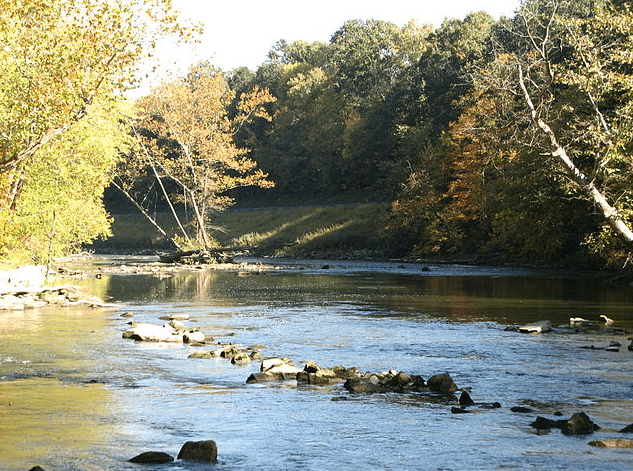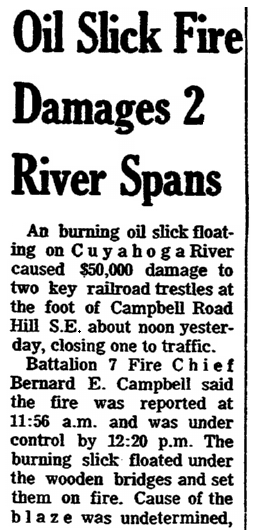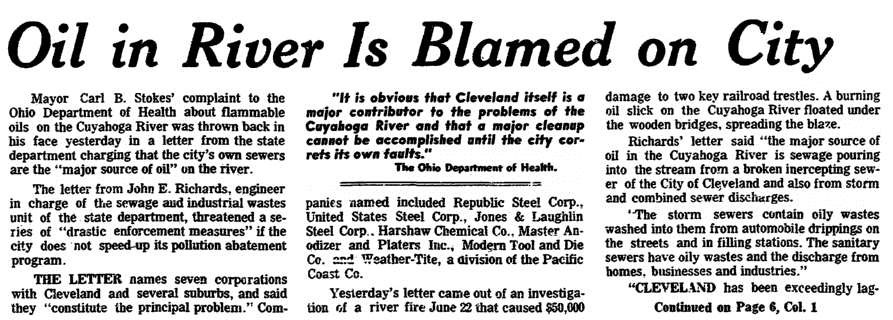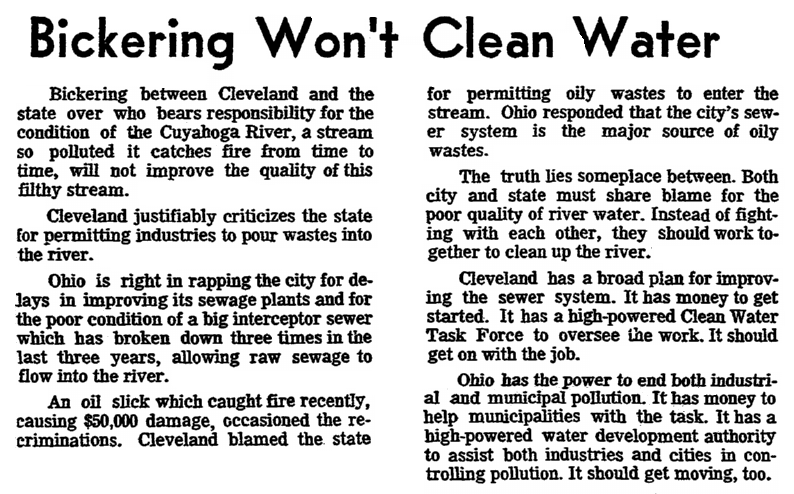On 22 June 1969, America’s environmental awareness received a jolt when the Cuyahoga River in Ohio caught fire. The sight of water burning startled and dismayed the nation and helped solidify the growing environmental movement. It was a wake-up call the nation badly needed.

In 1969 the Cuyahoga River was a grossly polluted body of water. Roughly half of the 85-mile long river was completely devoid of fish, from Akron to the river’s mouth at Cleveland where it empties into Lake Erie. There were so many industrial pollutants, waste products, oil and kerosene routinely dumped into the river that it actually caught fire several times before, but the 1969 blaze was the one that resulted in public attention and government response. This in no small part was due to an article in Time magazine that stated the river “oozes rather than flows.”
An aroused American public and the growing might of the environmental movement exerted pressure on local, state and federal governments to take action. The outcry over the Cuyahoga River fire is often cited as one of the moving forces behind a string of important environmental laws and agencies that were created, including the Environmental Protection Agency (December 1970), the Clean Water Act and the Ohio Environmental Protection Agency (both October 1972).
Today the Cuyahoga River still faces pollution issues, but its recovery has begun. Water quality has improved, and that once-dead stretch of river now supports 44 species of fish. In 1998 the Cuyahoga River became one of 14 American Heritage Rivers, and on 11 October 2000 the Cuyahoga Valley National Park was created – the only national park in Ohio.
The following four articles from Cleveland’s leading newspaper describe the river fire and its aftermath. The first is a short article buried on page 33 that simply reported that the fire occurred. The next day another article appeared, this one on page 34, saying the city was investigating the fire. Then, two weeks later, the Cuyahoga River fire was front-page news as the city of Cleveland and the state of Ohio started hurling blame at each other. The fourth article is from the newspaper’s editorial board urging the local and state governments to stop wasting time accusing one another and instead focus their energies on cleaning up the river. All four articles were published by the Plain Dealer.

Here is a transcription of this article:
Oil Slick Fire Damages 2 River Spans
A burning oil slick floating on Cuyahoga River caused $50,000 damage to two key railroad trestles at the foot of Campbell Road Hill S.E. about noon yesterday, closing one to traffic.
Battalion 7 Fire Chief Bernard E. Campbell said the fire was reported at 11:56 a.m. and was under control by 12:20 p.m. The burning slick floated under the wooden bridges and set them on fire. Cause of the blaze was undetermined, said Campbell.
A fireboat battled the flames on the water while units from three battalions brought the fire on the trestles under control. Campbell said a bridge belonging to Norfolk & Western Railway Co. sustained $45,000 damage, closing both of its tracks.
The other, one-track trestle, is open. The fire did $5,000 damage to the timbers of this Newburgh & South Shore Railroad Co. crossing.
Flames climbed as high as five stories, said Campbell.
Campbell pointed out a fireboat patrols the Cuyahoga River daily checking for oil slicks and clearing them away. He said waterfront industries are responsible, dumping oil wastes into the river rather than reclaiming them.

Here is a transcription of this article:
City Investigating Cause of River Fire
A fire on the Cuyahoga River Sunday which caused $45,000 damage is under investigation by the city’s Bureau of Industrial Waste, Utilities Director Ben S. Stefanski II said yesterday.
Stefanski said investigators are attempting to learn what type of combustible substance was dumped into the river and by what company.
“It probably had to be some kind of gasoline or kerosene,” Stefanski said. “The oil that usually gets into the river by dumping or discharge from boats, is of low grade and would be noninflammable in the water.”
Stefanski and Mayor Carl B. Stokes yesterday toured the site of the fire which destroyed two railroad trestles.
A formal complaint to the state government will be filed by the mayor, Stefanski said, because of state licensing for industries along the river to dump pollutants in the river.
“We have no jurisdiction over what is dumped in there. The state licenses the industries and gives them legal authority to dump in the river. Actually, the state gives them a license to pollute.”
Stefanski said his department is compiling a list of industrial offenders along the river to include in the complaint to the state.

Here is a transcription of this article:
Oil in River Is Blamed on City
Mayor Carl B. Stokes’ complaint to the Ohio Department of Health about flammable oils on the Cuyahoga River was thrown back in his face yesterday in a letter from the state department charging that the city’s own sewers are the “major source of oil” on the river.
The letter from John E. Richards, engineer in charge of the sewage and industrial wastes unit of the state department, threatened a series of “drastic enforcement measures” if the city does not speed up its pollution abatement program.
The letter names seven corporations with Cleveland and several suburbs, and said they “constitute the principal problem.” Companies named included Republic Steel Corp., United States Steel Corp., Jones & Laughlin Steel Corp., Harshaw Chemical Co., Master Anodizer and Platers Inc., Modern Tool and Die Co. and Weather-Tite, a division of the Pacific Coast Co.
Yesterday’s letter came out of an investigation of a river fire June 22 that caused $50,000 damage to two key railroad trestles. A burning oil slick on the Cuyahoga River floated under the wooden bridges, spreading the blaze.
Richards’ letter said “the major source of oil in the Cuyahoga River is sewage pouring into the stream from a broken intercepting sewer of the city of Cleveland and also from storm and combined sewer discharges.
“The storm sewers contain oily wastes washed into them from automobile drippings on the streets and in filling stations. The sanitary sewers have oily wastes and the discharge from homes, businesses and industries.”
“Cleveland has been exceedingly laggard in carrying out the pollution abatement program to which it agreed in representative appearances before the Ohio Water Pollution Board,” the letter charged.
Richards threatened three possible measures to enforce the pollution control:
1) A freeze on all new building in the city.
2) A ban on industrial expansion any place where waste treatment is inadequate.
3) Legal action to close industrial plants that do not cooperate.
No time limit is set in the letter, but Richards said “the Water Pollution Control Board will take up each case individually. It currently has under consideration the City of Cleveland’s request for renewal of its waste discharge permit.”
The letter names six needs in which the city has been slow in meeting its own program. “It is obvious that Cleveland itself is a major contributor to the problems of the Cuyahoga River and that a major cleanup cannot be accomplished until the city corrects its own faults,” the letter said.

Here is a transcription of this article:
Bickering Won’t Clean Water
Bickering between Cleveland and the state over who bears responsibility for the condition of the Cuyahoga River, a stream so polluted it catches fire from time to time, will not improve the quality of this filthy stream.
Cleveland justifiably criticizes the state for permitting industries to pour wastes into the river.
Ohio is right in rapping the city for delays in improving its sewage plants and for the poor condition of a big interceptor sewer which has broken down three times in the last three years, allowing raw sewage to flow into the river.
An oil slick which caught fire recently, causing $50,000 damage, occasioned the recriminations. Cleveland blamed the state for permitting oily wastes to enter the stream. Ohio responded that the city’s sewer system is the major source of oily wastes.
The truth lies someplace between. Both city and state must share blame for the poor quality of river water. Instead of fighting with each other, they should work together to clean up the river.
Cleveland has a broad plan for improving the sewer system. It has money to get started. It has a high-powered Clean Water Task Force to oversee the work. It should get on with the job.
Ohio has the power to end both industrial and municipal pollution. It has money to help municipalities with the task. It has a high-powered water development authority to assist both industries and cities in controlling pollution. It should get moving, too.
Note: An online collection of newspapers, such as GenealogyBank’s Historical Newspaper Archives, is not only a great way to learn about the lives of your ancestors – the old newspaper articles also help you understand American history and the times your ancestors lived in, and the news they talked about and read in their local papers. This is true of more recent events and family history as well.
